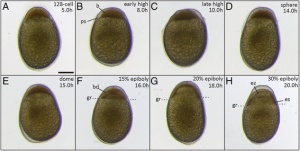User:Z3462297
Lab Attendance
Lab 1 --Z3462297 (talk) 13:47, 7 August 2015 (AEST)
Lab2 --Z3462297 (talk) 13:19, 14 August 2015 (AEST)
Lab 3 --Z3462297 (talk) 12:26, 21 August 2015 (AEST)
Lab Assessment 1
1. <pubmed>25830275</pubmed>
Over time, massage therapy has been widely used to treat physical pain and mental difficulties and currently causes no significant adverse effects or risks to the patient. The purpose of this study was to investigate the impact of deep relaxation therapy (andullation) using oscillating vibrations on blastocyst transfer in in vitro fertilisation (IVF) cryo-cycles. The 267 IVF patients that participated in this study collectively had a mean age of 36.3 years and all previously received a transfer of vitrified, warmed blastocysts. Before embryo transfer, the test group received a deep relaxation massage for 30 minutes on a vibrating device, in comparison to the control group that underwent no changes. The main measurable factors included pregnancy rates using a urine test for hCG, ongoing pregnancies by examining the fetal heartbeat and birth rates, and miscarriage rates.
The results showed that patients who received andullation therapy before embryo transfer, had significantly greater pregnancy rates, ongoing pregnancies and birth rates compared to those who did not, regardless of age and hormonal status.
- Pregnancy rates: test group 58.9%, control group 41.7%
- Ongoing pregnancies: test group 53.6%, control group 33.2%
- Birth rates: test group 32%, control group 20.3%
The research team concluded that andullation therapy preceding to blastocyst transfer in cryo-cycles greatly improve implantation, as it reduces stress, uterine contractions and may also enhance blood flow in the abdomen. Ultimately, these findings have showed that massage therapy is a suitable method to enhance assisted-reproduction techniques (ARTs).
2. <pubmed>26054135</pubmed>
Acupuncture and moxibustion are key natural therapies that play a role in traditional Chinese medicine, and have been a recommended treatment for various conditions. The aim of the investigate was to observe the effects of acupuncture and moxibustion on pregnancy in IVF-embryo transfer (IVF-ET) patients, and to determine its application value in IVF-ET treatment. 114 IVF-ET patients that were treated with standard long-term program at luteal phase were equally and randomly divided into a test and control group. The test group underwent one session of acupuncture and moxibustion treatment before embryo-transfer, thus a total of 3 sessions of the therapy were undertaken. The control group did not receive acupuncture or moxibustion prior to ET. Measurable factors of this experiment included: "endometrial morphology and blood flow, levels of estrogen, progesterone and luteinizing hormone when hCG was injected, gonadotropin dosage, number of oocytes, high-quality embryo number, embryo cultivation rate and pregnancy rates" (Chen and Hau, 2015).
Patients treated with acupuncture and moxibustion revealed significantly higher estrogen levels on the day of hCG injections and high-quality embryo rate. It was also noted that endometrial blood flow and morphology was affected such that endometrial receptivity was increased. Therefore with further analysis into application and specific impacts, the researcher suggests acupuncture and moxibustion will improve IVF-ET outcome in patients and be a key assistant therapeutic.
Lab Assessment 2
| Uploading Images in 5 Easy Steps | ||
|---|---|---|
First Read the help page Images and Copyright Tutorial.
Students cannot delete images once uploaded. You will need to email me with the full image name and request deletion, that I am happy to do with no penalty if done before I assess. Non-Table version of this page
|
Embryos during late blastula phase and early gastrulation[1]
PMID 25887993
Lab Assessment 3
The following are research articles discussing possible treatments for male infertility
1. <pubmed>22958644</pubmed> This article investigates the use of clomiphene citrate, hCG and human menopausal gonadotropin (hMG), to treat oligospermia as they increase hormones that are essential for successful spermatogenesis to occur, including FSH and testosterone.
2. <pubmed>26097523</pubmed>
The research discussed in this article discusses the advantages of using cerium dioxide nanoparticles (CNPs) to treat male infertility due to its antioxidant effects. The research team experimented on male rats to observe CNP effects on male health and infertility as oxidative stress plays a key role in preventing proper spermatogenesis.
3. <pubmed>4023371</pubmed>
Research article also focuses on the effects of oxidative stress on male fertility. It discusses the use of lycopenes as a possible treatment for infertility disorders due to its antioxidant properties, as well as contributing to gap junction communication, modulation of gene expression, regulation of the cell cycle and immunological aspects.
Please do not use your real name on this website, use only your student number.
- 2015 Course: Week 2 Lecture 1 Lecture 2 Lab 1 | Week 3 Lecture 3 Lecture 4 Lab 2 | Week 4 Lecture 5 Lecture 6 Lab 3 | Week 5 Lecture 7 Lecture 8 Lab 4 | Week 6 Lecture 9 Lecture 10 Lab 5 | Week 7 Lecture 11 Lecture 12 Lab 6 | Week 8 Lecture 13 Lecture 14 Lab 7 | Week 9 Lecture 15 Lecture 16 Lab 8 | Week 10 Lecture 17 Lecture 18 Lab 9 | Week 11 Lecture 19 Lecture 20 Lab 10 | Week 12 Lecture 21 Lecture 22 Lab 11 | Week 13 Lecture 23 Lecture 24 Lab 12 | 2015 Projects: Three Person Embryos | Ovarian Hyper-stimulation Syndrome | Polycystic Ovarian Syndrome | Male Infertility | Oncofertility | Preimplantation Genetic Diagnosis | Students | Student Designed Quiz Questions | Moodle page
Glossary Links
- Glossary: A | B | C | D | E | F | G | H | I | J | K | L | M | N | O | P | Q | R | S | T | U | V | W | X | Y | Z | Numbers | Symbols | Term Link
References
PMID 26244658
Look at this article on fertilisation.[2]
here's the list
